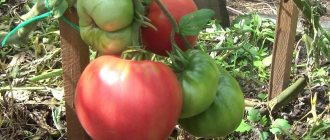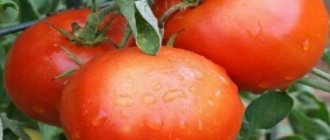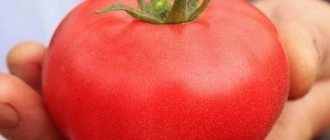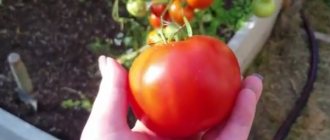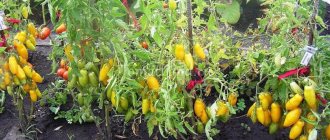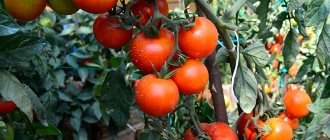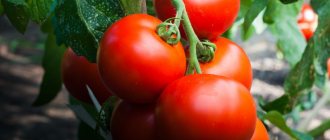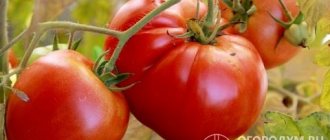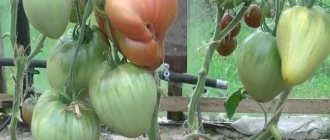Everyone's favorite tomatoes come in many varieties. There are specially bred small-fruited varieties - “cherries”, which can be grown even at home. These varieties include Pinocchio, an early-ripening tomato that feels great at home.
- 2 What does a Pinocchio tomato look like?
- 3 Advantages and disadvantages of the variety
3.1 Table: comparison of Pinocchio with some other cherry varieties
3.1.1 Photo gallery: varieties of cherry tomatoes
- 4.1 Video: growing Pinocchio tomato on a windowsill
General information about the variety
The cultivar was included in the list of domestic breeding achievements (State Register) in 1997. The originator of the indoor tomato is Aleksasheva Marina Vitalievna.
Pinocchio is a medium-ripening tomato. From germination to harvest, an average of 100-115 days pass.
Characteristics of the bush
Pinocchio is a low-growing standard-type tomato. This means that the plant does not require garters or pinching, which greatly facilitates caring for the crop at home and in the open ground.
The height of the bush does not exceed 20-35 cm. The leaves of the cultivar belong to the intermediate type, are medium-dissected, and have a dark green color.
Description and taste of fruits
Pinocchio produces small flat-round cherry fruits, the weight of which does not exceed 20 g.
At the stage of technical ripeness, tomatoes are light green with a dark spot in the stalk area. Fully ripened fruits acquire a deep red color. There are 2 or 3 chambers inside a tomato.
The taste qualities of the variety were determined by the state variety commission to be excellent and good. This is confirmed by the reviews of vegetable growers left about the Pinocchio variety.
Productivity and Application
The yield of Pinocchio tomato declared by the manufacturer is 1-1.5 kg per plant. Such results can be achieved only with the correct agricultural technology for indoor tomatoes.
The fruits are intended for fresh consumption, preparing salads and for pickling for the winter.
How to use the fruit
The Pinocchio tomato begins to bear fruit in August–September. Tomatoes achieve their best taste when fully ripe.
Small tomatoes are ideal for canning in small jars
The Pinocchio crop can be consumed fresh, and can also be used for whole-fruit canning, and they can be placed in the same container with other varieties of tomatoes. Thanks to the excellent taste, Pinocchio tomatoes can be used to prepare various sauces or juice.
Cherry tomatoes make delicious juice
Planting dates and sowing
At home, Pinocchio tomatoes can be grown all year round if you create a favorable environment for the development of the crop: high-quality lighting, suitable temperature, regular fertilizing.
If the tomato will grow on a balcony, in a greenhouse or open ground, the manufacturer’s recommended sowing time is the third ten days of March (from the 20th to the 30th of the month).
Selection of landing containers
If you plan to cultivate the Pinocchio tomato variety in the future in open ground, common seedling boxes are suitable for sowing. At the stage of formation of 2-3 leaves, seedlings are planted in separate cups.
When growing at home, it is recommended to choose specialized pallets, of which there is now no shortage in gardening stores.
You can also take 200 ml plastic transparent cups. 2-3 seeds are planted in them at once. After germination, one or two weaker seedlings will have to be separated by cutting them off at the root with nail scissors.
Preparing seeds and soil
It is recommended to use specialized soil for homemade tomatoes - for tomato seedlings. It allows air and water to pass through well and contains all the necessary elements that plants will need at the first stage of development.
It is recommended to pre-disinfect purchased soil. This will avoid problems at the stage of growing seedlings, such as blackleg.
The soil can be frozen on the balcony 2 weeks before planting, calcined in the oven, and poured with boiling water.
If none of the options are suitable, the substrate should be shed with at least a solution of Fitosporin. The drug suppresses pathogenic fungal flora of the soil mixture and populates it with beneficial microorganisms.
Pinocchio seeds are also pickled in a Fitosporin solution for 1-2 hours. Afterwards, the planting material is dried and planted in the prepared soil.
Planting seeds
When planting in a common container, the distance between the seeds in the furrow should be at least 1 cm and 2 cm in the row spacing.
The Pinocchio variety has small seeds, unlike the usual medium and large-sized tomatoes. Therefore, it is not recommended to lay planting material to great depths. Otherwise, the seedling will not have enough strength to reach the surface. The recommended embedment depth is no more than 0.5 cm.
The planted seeds are sprinkled with a substrate, the surface of the ground is moistened with a spray bottle, and covered with film or glass to create a greenhouse effect. Place in a warm place. In an apartment, this may be the area under the heating radiators.
The crops are ventilated 2-3 times daily, leaving the planting containers open for half an hour.
Check the soil moisture regularly. It should not dry out, but it should not be allowed to soak either. Wet the soil moderately as it dries.
As soon as the first seedlings begin to hatch, the shelter is removed and the seedling boxes are placed closer to the light source.
Reviews from gardeners
Gennady, Anapa
Where grown: open ground.
“I love cherry tomatoes, they seem neat to me. I purchased the Pinocchio variety last year, just for testing. And I didn’t regret it. Not only was the yield quite good, but I also didn’t get sick! And for some reason the insects avoided him, probably thinking that he was still very small!))). I collected seeds for next year, so I will plant more!”
Love, Irkutsk
Where I grew it: windowsill.
“What I like about the Pinocchio variety is that it can be grown all year round! Sometimes you really want to try fresh tomatoes, but somehow you don’t want to go to the store for bland, tasteless and expensive tomatoes. That's why I planted him. When I harvested my first harvest, I immediately posted a photo to show off! Now I even treat guests, and dry it, and salt it. And I recommended it to all my friends!”
Armen, Vorkuta
Where grown: windowsill.
“I’ll be honest: I’m a lazy summer resident. I don’t like to mess around in the garden all the time, constantly spraying the bushes with poison from all kinds of insects, fighting weeds or loosening the soil. Therefore, Pinocchio is just a salvation for me: small, convenient, does not take up much space. If you want tomatoes all year round (unless, of course, you are going to grow them industrially), take this variety.”
Growing seedlings
When planting seeds in March and keeping the seedlings on a south or south-east windowsill, Pinocchio seedlings will have enough light. When sowing earlier or growing tomatoes on the non-sunny side, additional lighting will be required. Tomatoes need additional lighting for 12 hours a day.
After the formation of 2-3 true leaves, Pinocchio seedlings are planted in separate 200 ml cups. The procedure is necessary if tomatoes will be grown in open ground.
If the tomatoes were planted on pallets, the transplanting process can be delayed for several weeks. In the latter case, the procedure is carried out using the transshipment method.
When grown in separate cups, seedlings are sprinkled with soil along the cotyledons.
After picking, the seedlings are fed 2 weeks later with a special complex for tomato seedlings (Agricola, Orton-seedling, Zdraven, etc.).
When grown in separate containers and pallets, fertilizer is given for the first time after the formation of 3-4 leaves on the seedlings.
Every 10 days, Pinocchio seedlings are treated with Epin, which can be alternated with Zircon.
After 2 months, the tomatoes are transplanted into separate 3-5 liter pots or planted in open ground.
Advantages
- Easy to care for;
- Good seed germination, judging by most reviews, this figure is close to 90-100%;
- Does not require stepsoning;
- Suitable for growing both on the balcony and in open ground;
- High resistance to diseases;
- You can plant next to tall varieties, so to speak, plant beds with them, it does not take up much space;
- Has a pleasant taste;
- Good for canning;
- The bush itself has a pleasant decorative appearance.
Growing tomatoes in pots on a windowsill
The tomato is transferred into a large pot, trying to carefully remove it from the old container without damaging the earthen lump. Sprinkle with soil and water abundantly.
According to reviews and photos on the Internet, the Pinocchio tomato is successfully grown on the balcony in ordinary plastic 5-liter bottles.
Next, the bushes need the following care:
- watering as the substrate dries;
- loosening the soil in the pot 1-2 times a week;
- root feeding once every 3 weeks;
- treatment of half a leaf with Epin once every 10-14 days.
After the second flower cluster is extended, Pinocchio is given fertilizer with a high content of potassium and phosphorus, necessary for the formation of fruits. The drug can be used as a fertilizer at this stage. During the flowering period, tomatoes also respond well to boric acid.
When growing Pinocchio on a windowsill, preventive treatments against diseases and pests are usually not necessary. The exception is when there are sick indoor plants at home that are infested with pests.
When kept on the balcony and in hanging pots near the house, preventive treatment with Fitosporin against fungal diseases is desirable.
The fruiting period for Pinocchio when grown at home begins in late July and early August.
Video: Pinocchio tomato variety, review
If you grew Pinocchio tomatoes, please write how tall your bush turned out to be. Did you tie it to a support? Will you grow it again? Briefly describe what advantages and disadvantages this tomato has in your opinion. If possible, attach to the comment a photo of the entire bush as a whole or individual fruits that you grew. Thank you!
Your feedback on the Pinocchio tomato and additions to the description will help many gardeners evaluate this tomato and decide whether it is worth planting or not.
You can give your rating to the variety by clicking on the desired number of stars. Typically, a variety is evaluated based on the following characteristics: fruit taste, appearance, yield, disease resistance, and overall impression of the tomato.
Cultivation in open ground
In the southern regions, you can move Pinocchio tomato seedlings to the beds in mid-May. For the Northern strip, suitable planting dates are the end of May or the beginning of June.
In open ground, they adhere to the arrangement between the bushes - 50 by 30 cm.
Planting process:
- The seedling is carefully removed from the cup, trying not to damage the earthen lump.
- Place the plant in the center of the prepared hole so that the lower leaves are located just above the edge of the hole.
- Sprinkle with earth and press it around the bush.
- Water generously.
The procedure is carried out on a cloudy morning or evening.
Agricultural technology for cultivating in beds is standard:
- Watering as needed;
- Loosening the soil once a week.
- Feeding 3 times per season.
When cultivated in open ground, Pinocchio does not need as frequent feeding as when kept in pots on a windowsill or balcony. There the plant is kept in a confined space and quickly consumes the nutrients that it needs to be supplied through regular feeding.
When grown in beds for the first time, the crop is fed after transplantation after 2 weeks. Then Pinocchio is fertilized in the flowering phase, adhering to the same rules in feeding the tomato as when maintaining a house. Use specialized fertilizers marked “Ovary” or boric acid. Pinocchio also responds well to feeding with superphosphate.
In open ground, it is imperative to prevent fungal diseases by spraying the bushes with Fitosporin.
The first harvest begins to form in early to mid-August.
The history of cherry tomatoes
After tomatoes were introduced to Europe, small-fruited tomatoes were cultivated on the Greek island of Santorini. They liked the island's volcanic soil and dry climate. The history of varietal cherry tomatoes dates back to 1973. It was then that Israeli scientist-breeders obtained the first cultivated varieties of small-fruited tomatoes. They were sweet, kept well, and held up well in transit. Since then, cherry tomatoes have spread all over the world, and their varieties and hybrids are becoming more and more numerous.
Among them there are both tall and very tiny ones. We will introduce you to one of them today. This is a Pinocchio tomato variety, the full characteristics and description of which are presented below. Here is his photo.
Similar varieties
According to the characteristics and description of the variety, many tomatoes intended for windowsills and balconies are similar to Pinocchio:
- Balcony Miracle is a dwarf cultivar of ultra-early ripening. Just like Pinocchio, it can be grown in any conditions - on a window, balcony, unprotected beds. Suitable for cultivation in open ground without seedlings. Tomatoes are larger than Pinocchio's and can weigh up to 40 g when grown in garden beds. In this case, the height of the bush is usually no more than 30 cm.
- Bonsai is one of the best balcony varieties with an ultra-early ripening period. The dwarf bush does not exceed 20-30 cm in height at home. The manufacturer assures that pots with a volume of no more than 2 liters are suitable for growing the crop at home. During the fruiting period, the bushes are covered with cherry tomatoes weighing up to 25 g.
- Indoor surprise - a super early tomato that produces plum-shaped fruits weighing up to 60 g. The height of the bush does not exceed 50 cm.
- Baby - produces the first harvest 85-90 days after germination. It bears fruit abundantly, forming cherry tomatoes weighing 12-15 g on miniature, compact bushes. It is highly decorative.
Pest and disease control
Indoors, the cherry variety does not suffer from diseases and pests. But if the watering schedule is violated or the soil is poorly disinfected, young seedlings may develop blackleg disease. Affected plants must be removed. You can additionally carry out treatment with a quartz lamp to get rid of mold sources in the room.
In open ground, Pinocchio can be attacked by slugs or cabbageweeds. A solution of ammonia or metaldehyde (spray the soil) works well against the first pest. Against the second – Konfidor.
If a fungal infection has occurred on the Pinocchio tomato variety, then it should be treated with copper-containing preparations - Quadris, Bordeaux mixture, Hom. This can happen if there are diseased crops nearby.
Additional Tips and Warnings
- This variety is not susceptible to disease development, but can become diseased if not properly cared for. It is not recommended to spray the plant, since moisture ingress has a detrimental effect on the foliage and causes it to turn yellow.
- When the plant dries naturally, there is no need to take additional measures, since the bush has a short life span and drying is a normal process. Manifestations: gradual yellowing and drying of foliage and branches from top to bottom.
- During the growing season, it is necessary to remove weeds and loosen the soil, and at the time of transplanting seedlings, remove false leaves.
- During the flowering period, be sure to carefully shake the bushes, which helps them to pollinate efficiently.
- Ripe tomatoes should not be left on the branches - if you remove them in a timely manner, fruiting will be abundant.
- A lack of natural light can cause growth retardation, deterioration in the taste of fruits and even the death of the plant, so in winter it is recommended to provide additional lighting with fluorescent lamps.
The dwarf variety "Pinocchio" has a decorative appearance, high productivity and a rich mineral composition. The lush foliage of the plant in combination with small bright fruits allows you to grow the variety as a potted plant at any time of the year, and the dense and strong tomatoes are suitable for whole-fruit canning and have a memorable sweet and sour taste.
How to grow tomatoes
Pinocchio tomatoes are planted in a permanent place in the second half of May. They are grown both in open and closed ground.
Some gardeners do not plant dwarf bushes in separate beds, but rather frame areas with other varieties of tomatoes or flower beds. Due to their low growth, they do not interfere with the growth of other crops. This variety is also grown in flowerpots in front of the house.
Planting seedlings in the ground
The land for growing tomatoes has been prepared since autumn. It is dug up and enriched with ash and humus. All remains of weeds and cultivated plants are removed.
In spring, the soil is dug up again and disinfected. To do this, water the soil with a weak solution of potassium permanganate.
Before planting in a permanent place, the seedlings are watered and fed. This is done 2-3 days before plant transplantation.
On the day of planting, holes are dug into the ground. It is recommended to place 7-8 holes on one square meter. Some gardeners practice more dense planting, placing 1 sq. m. up to 10 plants.
A tablespoon of ash is poured into the bottom of each hole. Plants are placed there. There is no need to deepen the bushes.
Warm water is poured into each well. The depressions are filled with soil.
Plant care
To get a rich harvest, it is important to follow all the rules for caring for tomatoes. The most important of them:
- Plants do not need to be pinched or shaped. A bountiful harvest is obtained precisely due to the large number of ovaries. Once a week, remove yellowed leaves from the bush.
- Water the tomatoes as the soil dries out. Usually do 2-3 waterings per week. Moisten the soil in the afternoon.
- Tomatoes need to be fed regularly. The first time fertilizing is applied 3 weeks after planting the plants in the ground. Then the tomatoes are fertilized every two weeks until the first inflorescences form. Experienced gardeners advise alternating mineral compositions and mullein solution. It is also useful to use foliar feeding when the first ovaries appear.
Nuances of caring for tomatoes
When growing dwarf tomatoes, consider a number of features. The tips presented in the list will help you avoid some mistakes and grow healthy plants:
- Tomatoes are susceptible to loosening the soil. This procedure improves root air exchange. Do this after each watering. During the loosening process, it is important not to damage the roots.
- Tap or well water is not suitable for watering tomatoes. Before using the water, it should sit for at least a day.
- The Pinocchio tomato does not tolerate moisture on its greens. Therefore, the bushes are watered from a watering can directly under the root.
- Pinocchio's root system is weak, so weeds easily damage it. To prevent this from happening, weeding is done at least once a week.
Diseases and pests
Pinocchio is a variety that is resistant to all tomato diseases. Thanks to the short growing season and early ripeness, it does not even suffer from late blight. Therefore, the only preventive measure it needs is to treat the seeds and soil with a disinfectant solution.
Tomatoes can be attacked by pests. Aphids, slugs, and the Colorado potato beetle appear on the bushes. The roots are damaged by the mole cricket and the larvae of the cockchafer.
All harmful insects are removed manually. To prevent their appearance on the bushes, tomatoes are treated with a soap solution or a decoction of chamomile and celandine. It is important that such products fall on the greenery and not on the soil.
To prepare a soap solution for spraying tomatoes, rub a piece of laundry soap into a bucket of water. When the soap crumbs dissolve, the product can be used.
The meaning of the decorative function
In addition to practical benefits, the aesthetic factor should be taken into account. Anyone who has planted an unusual variety of tomatoes notes the pleasure of seeing miniature scarlet fruits against the backdrop of green, dense foliage. Growing a dwarf plant is quite simple, but its appearance invariably evokes surprise, positive emotions and genuine interest among others.
You can find descriptions of tomatoes of this type grown upside down in hanging pots. Your efforts will pay off and become a source of pride when you hear rave reviews from friends and family about the unusual pet on the windowsill.
In addition, tasty and beautiful tomatoes look great in assorted preparations and can decorate dishes and salads on the holiday table with their presence.
Preparatory activities
Location, lighting, temperature, humidity
It is preferable to grow on the southwest, southeast side, the north side is not recommended for cultivation.
The plant is light-loving; daylight should be at least eight hours a day. The air temperature for sowing seeds is 20-35 degrees, when seedlings appear - 15-18 degrees, for further growth - 18-22 degrees. Optimal air humidity is 40-60% ; going beyond this range is not recommended.
Selection of capacity
- Flower pots: height no more than 15-20 centimeters, volume no more than 6-7 liters, but not less than 3 liters (necessary for the timely and correct development of the root system). Material – plastic, ceramics, clay, wood. Shape – round, rectangular.
- Boxes: the size should not exceed 25 by 40 centimeters with a box height of no more than 20 centimeters. Material – wood, plastic, polyethylene. Shape: square or rectangular.
- It is permissible to use plastic bottles with the top cut off , since their transparency allows for good regulation of soil moisture and watering.
Any container must have a tray.
Description
The plant is determinate, standard type, 25 - 30 cm high. The bush is compact due to moderate shoot formation, but it looks very decorative due to the elegant leaf mass and a large number of fruits similar to ripe cherries. The stem is strong and thick. The leaves are of intermediate type, with a mid-dissected plate, dark green in color. Up to 10 ovaries are formed in each Pinocchio fruit cluster. The peduncle of the variety has an articulation.
Miniature tomatoes are smooth, flat-round in shape. An unripe tomato is light green with a dark spot at the stalk; a ripe one turns red. The skin is glossy, dense, but some even call it harsh. The pulp is juicy, tender, there are 2 - 3 seed chambers, there are quite a lot of seeds. The taste is sweet. The State Register assesses the taste qualities as good and excellent. The weight of tomatoes is 15 - 20 grams, but sometimes 30 - 50 gram specimens grow.
Step-by-step care instructions
Watering and fertilizers
Watering is carried out regularly as the soil dries out. Avoid acidification or crusting. If the container for seedlings is transparent, watering is adjusted according to the appearance of the soil, making sure that mold does not appear on the edges of the container. Water for irrigation should be pre-settled for 3-5 days, at room temperature.
Fertilizers are introduced only after the fifth true leaf appears on the seedlings. The following is used as fertilizing:
- ready-made mineral fertilizers (“Superphosphate”, urea);
- wood ash;
- eggshells;
- Brewer's yeast.
Natural fertilizers are prepared according to the scheme of 20 grams per bush, or use mullein (1 part to 5 parts water) at the rate of 1 liter of solution per 1 bush. After 10-14 days, fertilizing is repeated with the same composition. It is allowed to fertilize during fruit set. 10 days before harvesting, feeding is stopped.
Temperature
Temperature conditions at night: the temperature must be maintained at least 18 degrees. During the daytime, the temperature should not be lower than 20-22 degrees.
Trimming and pinching
Pinching is carried out relative to the upper tip of the stem when it exceeds a height of 20-25 centimeters. This will allow the bush to grow more luxuriantly and produce more fruit. Branches that are too large are also pinched. It is necessary to remove excess flowers from the plant. Pruning is carried out only when the stem reaches 35 centimeters in order to prevent excessive growth in height.
Supports, hanging
This variety does not require staking or hanging as long as pinching and pruning are done correctly. The stem of the plant is strong and stable, supporting the entire bush well.
When growing a variety in greenhouse conditions or in open ground, supports are carried out if the height of the stem exceeds 35 centimeters, using wooden pegs or ladders.
It is possible to hang it from thin long pieces of material from trellises. Loosening of the soil is carried out after each watering in parallel with the removal of weeds.
